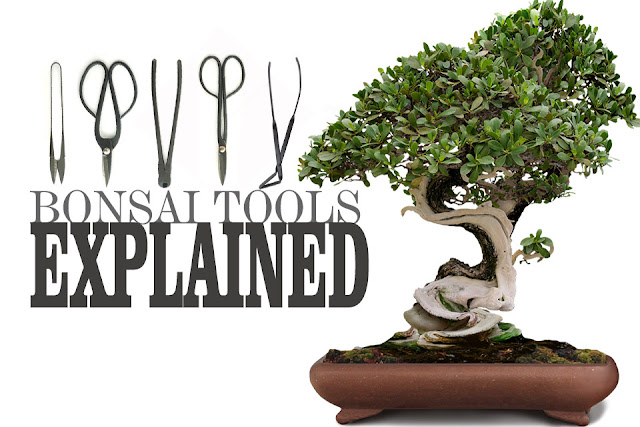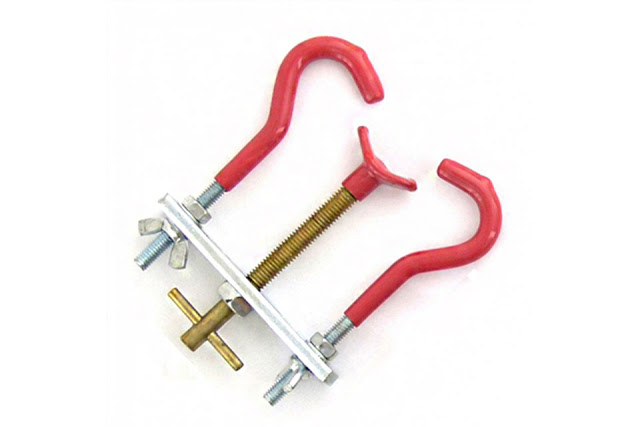Bonsai Tools Explained
Bonsai Tools Explained
A collection of tools defined to help novice bonsai gardeners grow into professionals
There are so many different bonsai tools, it can get confusing! This visual guide will help to answer any murky differences between each tool. Some tools seem as if they would be interchangeable, when they are absolutely not; while other tools can definitely be used in lieu of one another. Having all of this information will ensure the longevity of your bonsai plant. Damaging your tools and inflicting harm on to the bonsai will become a thing of the past.
First, here is a general explanation of several types of bonsai maintenance. Here you will also see what it is about these methods that makes them important for bonsai upkeep:
- Leaf trimming: Generally used in bonsai design to expose the bonsai's branches under groups of needles or leaves. Also good for maintenance of plant health.
- Pruning: Top of the trunk may be removed to making the more compact. Branches that conflict with the bonsai designer's vision will be removed while others may be shortened to fit within the planned design. Encouraging growth of non-pruned branches.
- Clamping: Larger bonsai, or one that have stronger wood, can use mechanical clamps for shaping branches and trunks. Most common are screw-based clamps, which straighten or bend part of the bonsai using greater force than wiring. Helps to manipulate the shape of the bonsai trunk and branches during growth.
- Grafting: New bonsai growing material (root, branch or bud) is introduced to a location beneath the bark of the tree.
- Defoliation: Essentially means cutting all the leaves off of the tree. It reduces the growth in the parts of the tree where this is done. Short-term dwarfing can be accomplished in certain bonsais by doing this.
Ikebana Saw
Literal meaning, "making flowers alive," that's exactly what this saw does. The sharp blade is designed for cutting branches off the bonsai. It has a lot of small, superfine teeth close together, ensuring ease of severing the desired branch. Skinny blade helps to reach awkward positions. This helps to remove dead branches with aims for a new branch to grow neath. Ridding undesirable branches leads to shaping the ideal plant formation.
Pruning Shear
Spring-loaded for fast action. Pruning is meant for trimming off dead or overgrown branches of the plant. Doing so encourages further growth of the plant. Carefully dismantling unhealthy branches brings about the vegetation waiting to grow in its place.
Butterfly Shear
Really good for the removal of the branches and also the leaves on the plant. Mainly used for pruning the top of the plant and its the roots. The wide grip of the handle allows for the shears to do this with larger parts of the plant.
Trimming Scissor
Perfect for aesthetic upkeep. Fits into tight spaces, allowing for precise defoliation. These are meant to help trim and thin out the plant, without damaging any tender shoots or blossoms, while still reaching the desired part of the plant you want to take off.Concave Cutter
This is an imperative tool for any bonsai enthusiast. The sharp blade is designed for cutting branches that are flush to the trunk. It allows for pruning seamlessly. Very good for minimizing damage a cut makes to the trunk of the bonsai, leading to rapid recovery time. Due to the closeness of the snip, it is almost untraceable afterwards, making the hole blend with the rest.
Knob Cutter
Also known as "knuckle cutter," it is known for its spherical-shaped blades. It's solitary purpose is to hollow out an incision made by a branch cutter. Its design allows for its user to work it like a chisel in order to gouge out excess plant matter.
Leaf Cutter
Used for the removal of unwanted leaves and buds. Induces growth where dead leaves are snipped. Small and easy to maneuver for quick defoliating.Rake with Pincers
Good for aerating the soil by loosening it up. The pincer can be used to readjust the roots of the tree whilst re-potting the plant. They are also great for grasping needles and other debris from around the plant.Root Rake
Meant to help with the removal and replanting of the bonsai. This rake helps to loosen up the roots of the plant out of the soil, making it much easier to dislodge. The flat edge can help to pack the soil betwixt the roots to better sturdy the plant.Wire Cutter
This cutter is the tool used to dismantle the wire system holding up the bonsai plant when it is time. Wire is used to shape the branches as they are growing. It is important to have due to it being sturdier than a lot of basic wire cutters. Using a weak wire cutter will result in a broken tool, due to the wire used is very thick. Helps to get very close cuts on the wire and not the plant.Root Pick
Meant to break through the soil whilst leaving the roots unharmed. The sharp point is great for carving down into the soil. It is smooth and rounded on the sides for the safety of the roots while eradicating the soil around them.Brush
Used for cleaning moss and the soil surfaces around the bonsai tree. Additionally, it can be swept up and down along the trunk of the plant to remove dirt and dead bark to make it appear cleaner and brighter.
Cactus Pincer
Generally longer than a regular pincer. Due to its elongated stature, it is meant to be used on plants that have pricks on them. Gets rid of the pesky, unwanted prickly stuff attached to the plant with ease from a distance.Jin Pliers
Made with short, powerful jaws. Aids in placing or dismantling the wire from the bonsai plant. Another thing jin pliers can be used for is stripping the bark of the tree. This is done for visual appeal to create a deadwood/aging effect on the trunk.Root Cutter
Will cut through thick root with only minimal damage caused to the tree itself. The steel blades are meant for severing the denser wood fibers commonly found in roots. Its flat cut can also be used to split the trunk, if so desired.Trunk Splitter
Splitting the trunk is the fastest way to strengthen the bonsai trunk. Typically, the trunk is separated into two pieces and then held together with wire. The trunk splitter is the best tool to use for splitting the trunk apart like this. Providing clean cuts with its steel shears, the trunk and branches are much more easily manipulated with the splitters.Branch Bender
For plant art purposes. Branch benders are utilized in order to transform the trunk or branches of the bonsai plant. With the pressure from fastening them to the plant, these make the tree bend and warp, reshaping the growth to different positions. The hooks and jacks are coated to maintain the safety of the bark.Sort through a collection of bonsai tools to find exactly what you need here.
Or, simply buy everything! Different size tool sets are also available at this link here.





















Comments
Post a Comment